MERCEDES-BENZ SL ROADSTER 2019 Workshop Manual
Manufacturer: MERCEDES-BENZ, Model Year: 2019, Model line: SL ROADSTER, Model: MERCEDES-BENZ SL ROADSTER 2019Pages: 330, PDF Size: 53.05 MB
Page 51 of 330
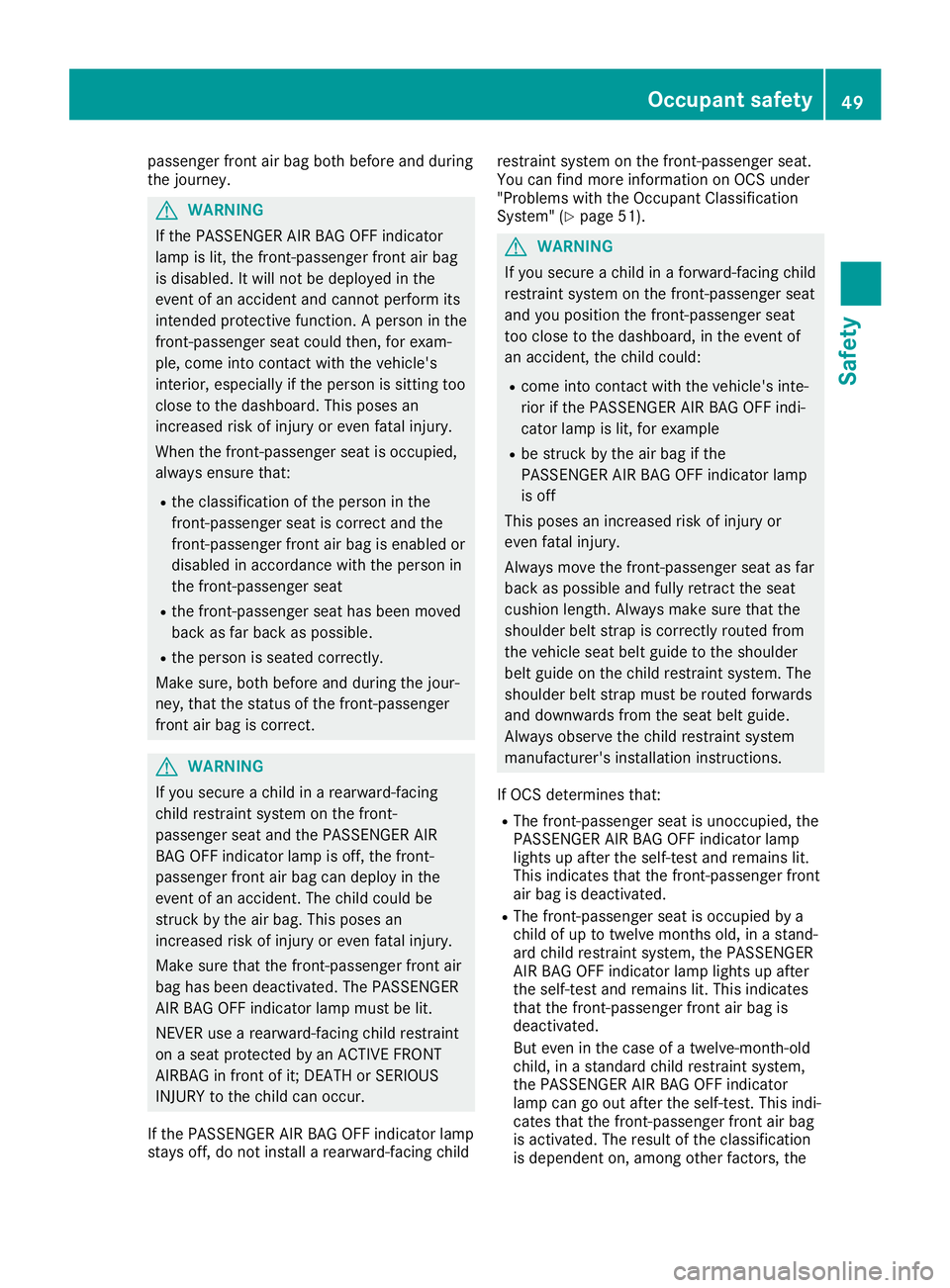
passenger
frontair bag both before andduring
the journ ey. G
WARN
ING
If the PAS SENGER AIRBAGOFF indicat or
lamp islit, the fron t-passenger frontair bag
is disabled. Itwill notbedeployed inthe
event ofan acciden tand cann otperfor mits
int ended protective func tion.A person inthe
fron t-passenger seatcould then,for exam-
ple, come intocon tact with thevehicle's
int erior, especially ifthe person issitt ing too
close tothe dashboard. Thisposes an
incr eased riskofinjury oreven fatalinjury.
When thefron t-passenger seatisocc upied,
always ensure that:
R the classific ationofthe person inthe
fron t-passenger seatiscorr ectand the
fron t-passenger frontair bag isenabled or
disabled inaccor dance withtheperson in
the fron t-passenger seat
R the fron t-passenger seathasbeen moved
back asfar back aspossible.
R the person isseated correctly.
Make sure,bothbefore andduring thejour-
ney, thatthestatusofthe fron t-passenger
fron tair bag iscorr ect. G
WARN
ING
If you secure achild inarearward-f acing
child restraint system onthe fron t-
passenger seatandthePAS SENGER AIR
BA GOFF indicat orlamp isoff, thefron t-
passenger frontair bag candeploy inthe
event ofan acciden t.The child could be
str uck bythe airbag. Thisposes an
incr eased riskofinjury oreven fatalinjury.
Make surethatthefron t-passenger frontair
bag hasbeen deactiv ated.ThePASSENGER
AIR BAGOFF indicat orlamp must belit.
NEV ERuse arearward-f acingchildrestraint
on aseat prote cted byan ACTIVE FRONT
AIRB AGinfron tof it;DE ATH orSERIOUS
INJURY tothe child canoccur.
If the PAS SENGER AIRBAGOFF indicat orlamp
stays off,donot installarearward-f acingchild rest
raint system onthe fron t-passenger seat.
You canfind more information onOCS under
"Problems withtheOcc upant Classification
System "(Y page 51). G
WARN
ING
If you secure achild inaforward- facingchild
rest raint system onthe fron t-passenger seat
and youposition thefron t-passenger seat
too close tothe dashboard, inthe event of
an acciden t,the child could:
R come intocon tact with thevehicle's inte-
rior ifthe PAS SENGER AIRBAGOFF indi-
cator lampislit, for example
R be struck bythe airbag ifthe
PAS SENGER AIRBAGOFF indicat orlamp
is off
This poses anincr eased riskofinjury or
even fatalinjury.
Always movethefron t-passenger seatasfar
back aspossible andfully retract the seat
cushion length.Always makesurethatthe
shoulder beltstrap iscorr ectlyrouted from
the vehicle seatbeltguide tothe shoulder
belt guide onthe child restraint system. The
shoulder beltstrap must berouted forwards
and downwards fromtheseat beltguide.
Always observe thechild restraint system
manufact urer'sinstallation instruct ions.
If OCS determ inesthat:
R The front-passenger seatisunocc upied, the
PAS SENGER AIRBAGOFF indicat orlamp
lights upafter theself-t estand remains lit.
This indicat esthat thefron t-passenger front
air bag isdeactiv ated.
R The front-passenger seatisocc upied bya
child ofup totwelve monthsold, inastan d-
ard child restraint system, thePAS SENGER
AIR BAGOFF indicat orlamp lights upafter
the self-t estand remains lit.This indicat es
that thefron t-passenger frontair bag is
deactiv ated.
But even inthe case ofatwelve- month-old
child, inastan dard child restraint system,
the PAS SENGER AIRBAGOFF indicat or
lamp cangoout after theself-t est.This indi-
cates thatthefron t-passenger frontair bag
is activ ated. Theresult ofthe classific ation
is dependen ton, among otherfactors, the Occupant
safety
49Safet y Z
Page 52 of 330
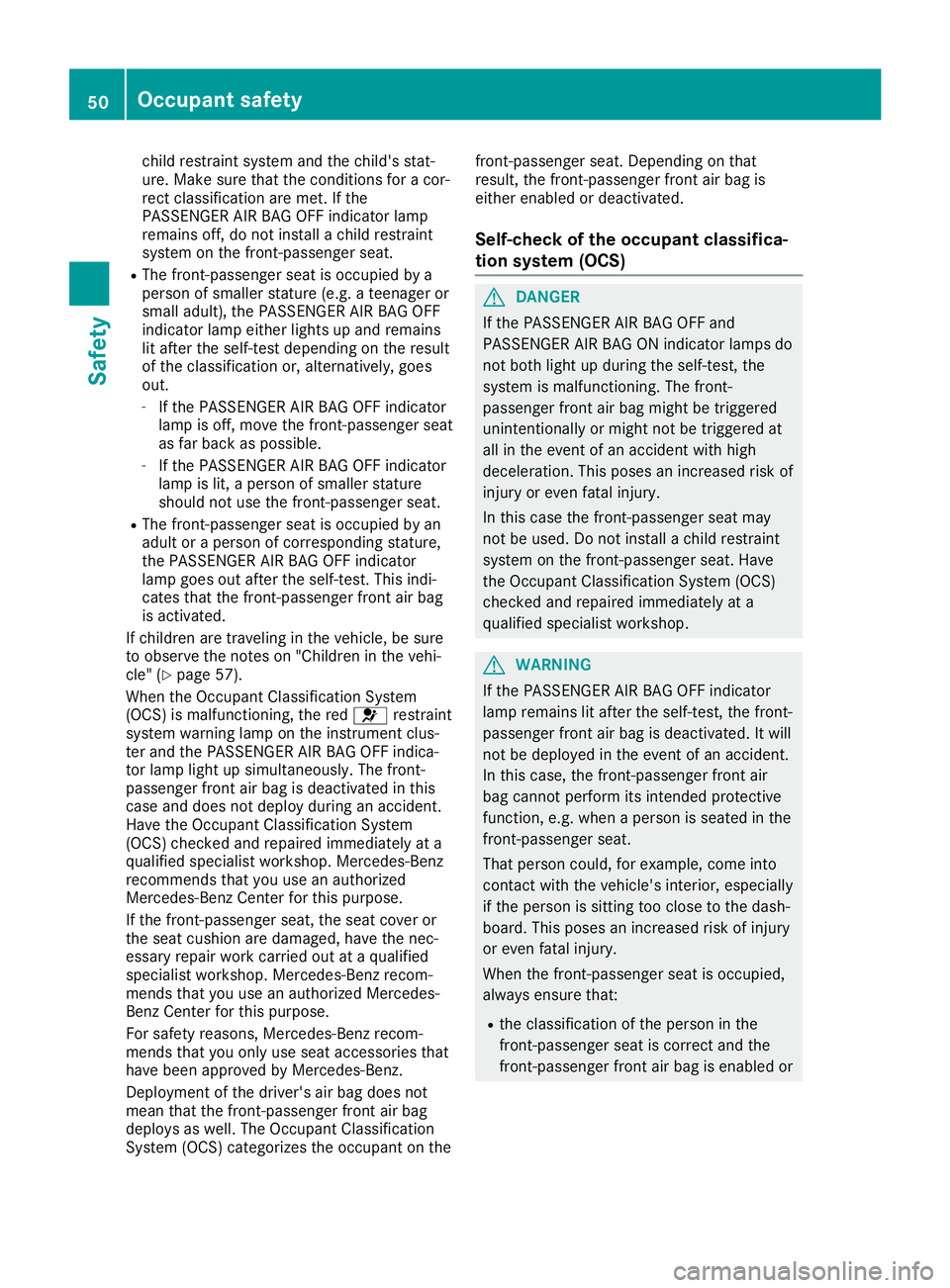
chil
drestra intsystem andthechild's stat-
ure .Ma kesure that thecondi tions foracor-
rect classifica tion aremet. Ifthe
PASSENG ERAIR BAG OFFindicator lamp
rema insoff, donot insta lla chil drestra int
sy stem onthe front-pa ssenger seat.
R The front-pa ssenger seatis occu pied bya
per son ofsma ller statu re(e.g .a teena geror
sma llad ult), the PASSENG ERAIR BAG OFF
indi cator lamp either lights upand rema ins
li t afte rthe self-test dependi ngon the resu lt
of the classifica tion or,alterna tively,goe s
ou t.
- Ifthe PASSENG ERAIR BAG OFFindicator
la mp isoff, move thefront-pa ssenger seat
as far back aspos sible.
- Ifthe PASSENG ERAIR BAG OFFindicator
la mp islit, aper son ofsma ller statu re
sho uld not usethe front-pa ssenger seat.
R The front-pa ssenger seatis occu pied byan
ad ultor aper son ofcorre sponding stature,
the PASSENG ERAIR BAG OFFindicator
la mp goesou tafte rthe self-test. Thisindi -
cates thatthefront-pa ssenger front airba g
is acti vate d.
If chil drenare trave ling inthe vehi cle,be sure
to obs erve thenotes on"Childre nin the vehi -
cle "(Y page 57).
Whe nthe Occup antClass ificati onSys tem
(OC S)ismal functi oning,the red 0075 restra int
sy stem warning lamp onthe instru ment clus-
ter and thePASSENG ERAIR BAG OFFindica-
tor lamp light upsim ultaneo usly.The front-
pa sse nger front airba gis dea ctiva tedinthis
case anddoesnot deployduring anacci dent.
Have theOccup antClass ificati onSys tem
(OC S)checke dand repaired imme diatel yat a
qu alifi ed spe cialist wo rksho p.Merce des-Benz
recom mendsthat youus ean authori zed
Merce des-Benz Center forthis purpo se.
If the front-pa ssenger seat,the seatcover or
the seatcus hionare damag ed,have the nec-
ess ary repairwo rkcarr ied ou tat aqu alifi ed
spe cialist wo rksho p.Merce des-Benz recom -
mend sthat youus ean authori zedMerce des-
Benz Center forthis purpo se.
For safety reasons, Merce des-Benz recom -
mend sthat youonly usesea tacce ssoriesthat
ha ve bee nap pro ved byMerce des-Benz.
Depl oyment ofthe driver' sai rba gdoe snot
mea nthat thefront-pa ssenger front airba g
dep loysas well. The Occup antClass ificati on
Sys tem (OCS)categ orizes theoccu pant on the front-pa
ssenger seat.Depe nding onthat
resu lt,the front-pa ssenger front airba gis
ei ther enabled ordea ctiva ted.
Se lf-c hec kof the occupan tcl assi fica-
tio nsys tem (OCS ) G
DA
NGER
If the PASSENG ERAIR BAG OFFand
PASSENG ERAIR BAG ONindicator lamps do
not both light upduring theself-test, the
sy stem ismal functi oning.The front-
pa sse nger front airba gmig htbe trigg ered
uni ntentiona lly or mig htnot betrigg eredat
al lin the eventofan acci dent with hig h
dece lerati on. Thispos esan incre asedris kof
inju ryor eve nfata linju ry.
In this case thefront-pa ssenger seatmay
not beused. Donot insta lla chil drestra int
sy stem onthe front-pa ssenger seat.Have
the Occup antClass ificati onSys tem (OCS)
checke dand repaired imme diatel yat a
qu alifi ed spe cialist wo rksho p. G
WARNI
NG
If the PASSENG ERAIR BAG OFFindicator
la mp rema inslit afte rthe self-test, thefront-
pa sse nger front airba gis dea ctiva ted.Itwi ll
not bedep loyed inthe eventofan acci dent.
In this case ,the front-pa ssenger front air
ba gcannot perform itsintend edpro tective
functi on,e.g. whenaper son issea ted inthe
front-pa ssenger seat.
Tha tper son could,for exa mpl e,come into
contact with the vehi cle'sinteri or,esp ecially
if the person issitti ngtoo clos eto the dash-
boa rd.Thispos esan incre asedris kof inju ry
or eve nfata linju ry.
Whe nthe front-pa ssenger seatis occu pied,
al wa ysensu rethat:
R the classifica tion ofthe person inthe
front-pa ssenger seatis corre ctand the
front-pa ssenger front airba gis ena bled or 50
Oc
cupan tsafe tySafe ty
Page 53 of 330
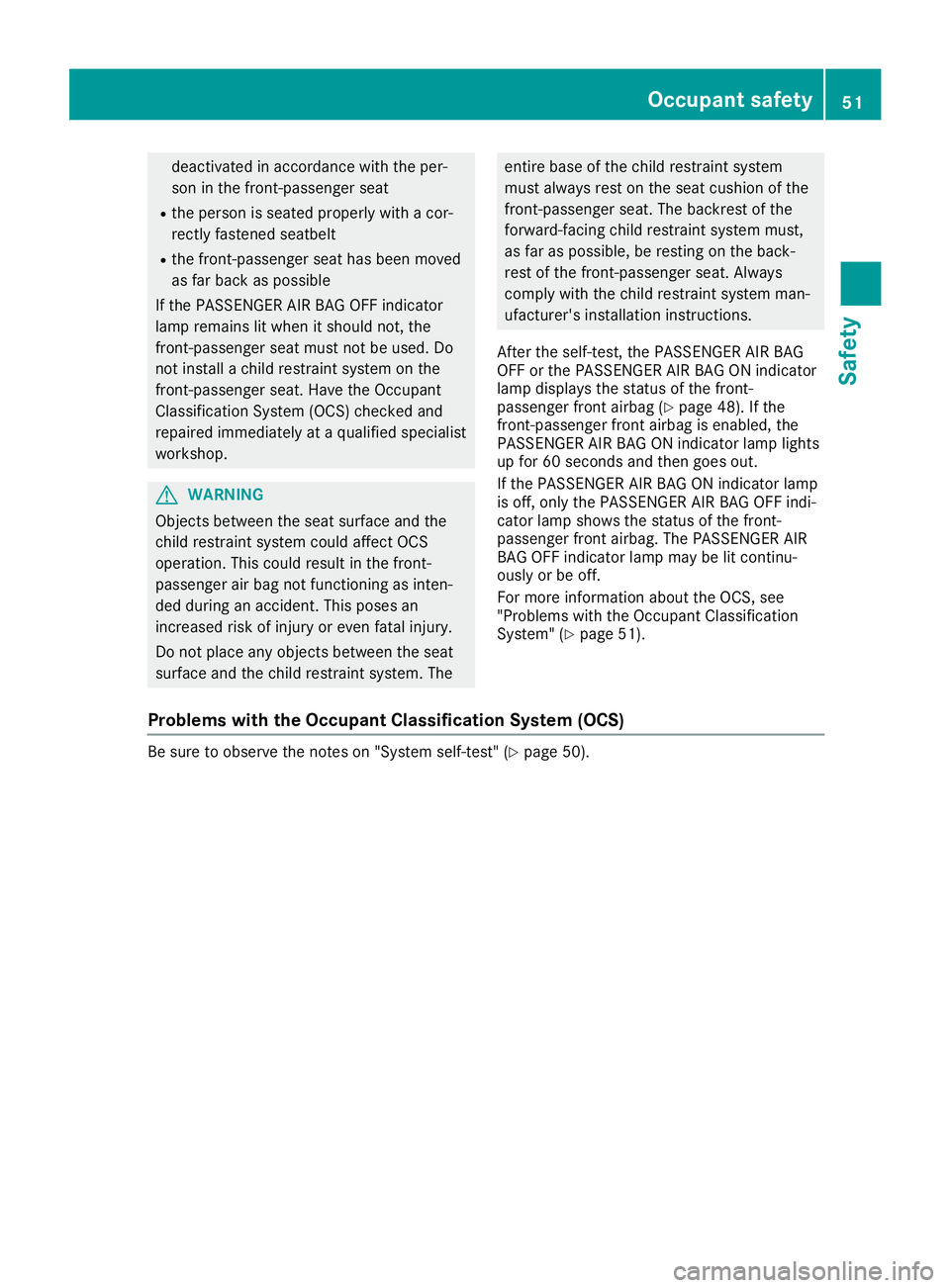
deactiv
atedinaccor dance withtheper-
son inthe fron t-passenger seat
R the person isseated properly withacor-
rect lyfasten edseatbelt
R the fron t-passenger seathasbeen moved
as far back aspossible
If the PAS SENGER AIRBAGOFF indicat or
lamp remains litwhen itshould not,the
fron t-passenger seatmust notbeused. Do
not installachild restraint system onthe
fron t-passenger seat.Have theOcc upant
Classification System(OCS)checkedand
repaired immediately ataqualified specialist
worksh op. G
WARN
ING
Objec tsbetween theseat surface andthe
child restraint system couldaffect OCS
operation .This could result inthe fron t-
passenger airbag notfunc tioningasinten-
ded during anacciden t.This poses an
incr eased riskofinjury oreven fatalinjury.
Do not place anyobjec tsbetween theseat
surface andthechild restraint system. The ent
irebase ofthe child restraint system
must always restonthe seat cushion ofthe
fron t-passenger seat.Thebackr estofthe
forward- facingchild restraint system must,
as far aspossible, berest ingonthe back-
rest ofthe fron t-passenger seat.Always
comply withthechild restraint system man-
ufactur er'sinstallation instruct ions.
Aft erthe self-t est,thePAS SENGER AIRBAG
OFF orthe PAS SENGER AIRBAGON indicat or
lamp displays thestatusofthe fron t-
passenger frontairbag (Ypage 48).Ifthe
fron t-passenger frontairbag isenabled, the
PAS SENGER AIRBAGON indicat orlamp lights
up for 60secon dsand then goes out.
If the PAS SENGER AIRBAGON indicat orlamp
is off, only thePAS SENGER AIRBAGOFF indi-
cator lampshows thestatusofthe fron t-
passenger frontairbag. ThePASSENGER AIR
BA GOFF indicat orlamp maybelitcon tinu-
ously orbe off.
For more information abouttheOCS, see
"Problems withtheOcc upant Classification
System "(Y page 51).
Problems withtheOccupant Classification System(OCS) Be
sure toobserve thenoteson "System self-test"(Ypage 50). Occupant
safety
51Safet y Z
Page 54 of 330
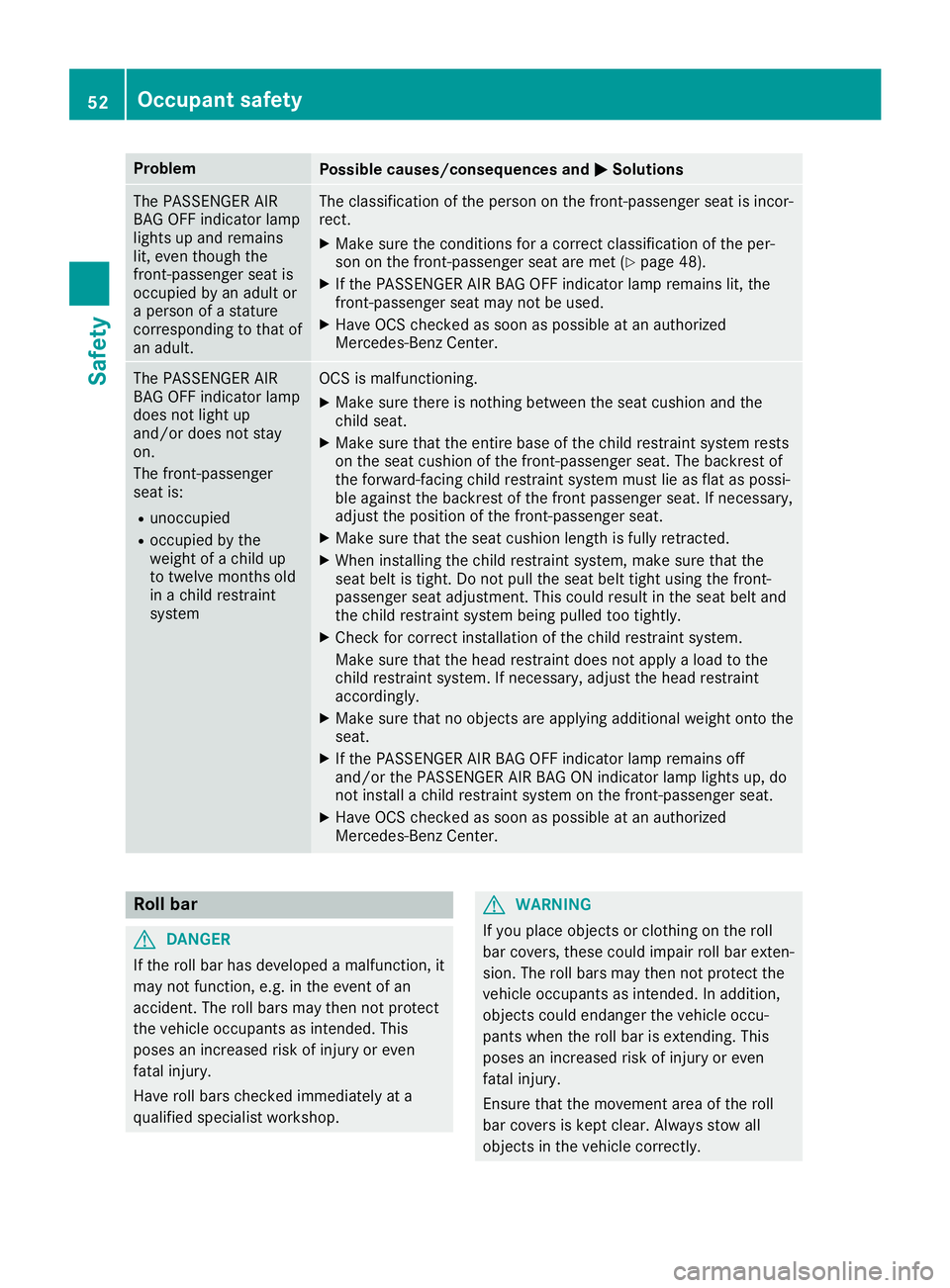
Problem
Possible
causes/co nsequences and0050 0050
Solutions The
PASS ENGER AIR
BAG OFFindicator lamp
lights upand remains
lit, even though the
front -passenger seatis
occupied byan adult or
a person ofastature
correspondin gto that of
an adult. The
classification ofthe person onthe front -passenger seatisincor-
rect.
X Make surethecondition sfor acorrect classification ofthe per-
son onthe front -passenger seataremet (Ypage 48).
X Ifthe PASS ENGER AIRBAG OFFindicator lampremains lit,the
front -passenger seatmaynotbeused.
X Have OCScheck edassoon aspossible atan authorized
Mercedes-Ben zCenter. The
PASS ENGER AIR
BAG OFFindicator lamp
does notlight up
and/or doesnotstay
on.
The front -passenger
seat is:
R unoccupied
R occupied bythe
weight ofachild up
to twelve monthsold
in achild restraint
system OCS
ismalfunctionin g.
X Make surethere isnothin gbetween theseat cushion andthe
child seat.
X Make surethattheentire baseofthe child restraint systemrests
on the seat cushion ofthe front -passenger seat.Thebackrest of
the forward-facing childrestraint systemmustlieasflat aspossi-
ble against thebackrest ofthe front passenger seat.Ifnecessary,
adjust theposition ofthe front -passenger seat.
X Make surethattheseat cushion lengthisfully retract ed.
X When installing thechild restraint system,makesurethatthe
seat beltistight. Donot pull theseat belttight using thefront -
passenger seatadjustment .This could result inthe seat beltand
the child restraint systembeingpulled tootightly.
X Check forcorrect installation ofthe child restraint system.
Make surethatthehead restraint doesnotapply aload tothe
child restraint system.Ifnecessary, adjustthehead restraint
accordingly.
X Make surethatnoobject sare apply ingadditional weightontothe
seat.
X Ifthe PASS ENGER AIRBAG OFFindicator lampremains off
and/or thePASS ENGER AIRBAG ONindicator lamplights up,do
not install achild restraint systemonthe front -passenger seat.
X Have OCScheck edassoon aspossible atan authorized
Mercedes-Ben zCenter. Roll
bar G
DANGER
If the rollbar has developed amalfunction, it
may notfunct ion,e.g. inthe event ofan
accident. Therollbars maythen notprotect
the vehicle occupants asinten ded.This
poses anincreased riskofinjury oreven
fatal injury.
Have rollbars check edimmediately ata
quali fiedspecialist workshop. G
WARNING
If you place object sor clothing onthe roll
bar covers, thesecouldimpair rollbar exten -
sion. Therollbars maythen notprotect the
vehicle occupants asinten ded.Inaddition,
object scould endanger thevehicle occu-
pants whentherollbar isexten ding.This
poses anincreased riskofinjury oreven
fatal injury.
Ensure thatthemovement areaofthe roll
bar covers iskept clear. Always stowall
object sin the vehicle correctly. 52
Occ
upantsafetySafety
Page 55 of 330
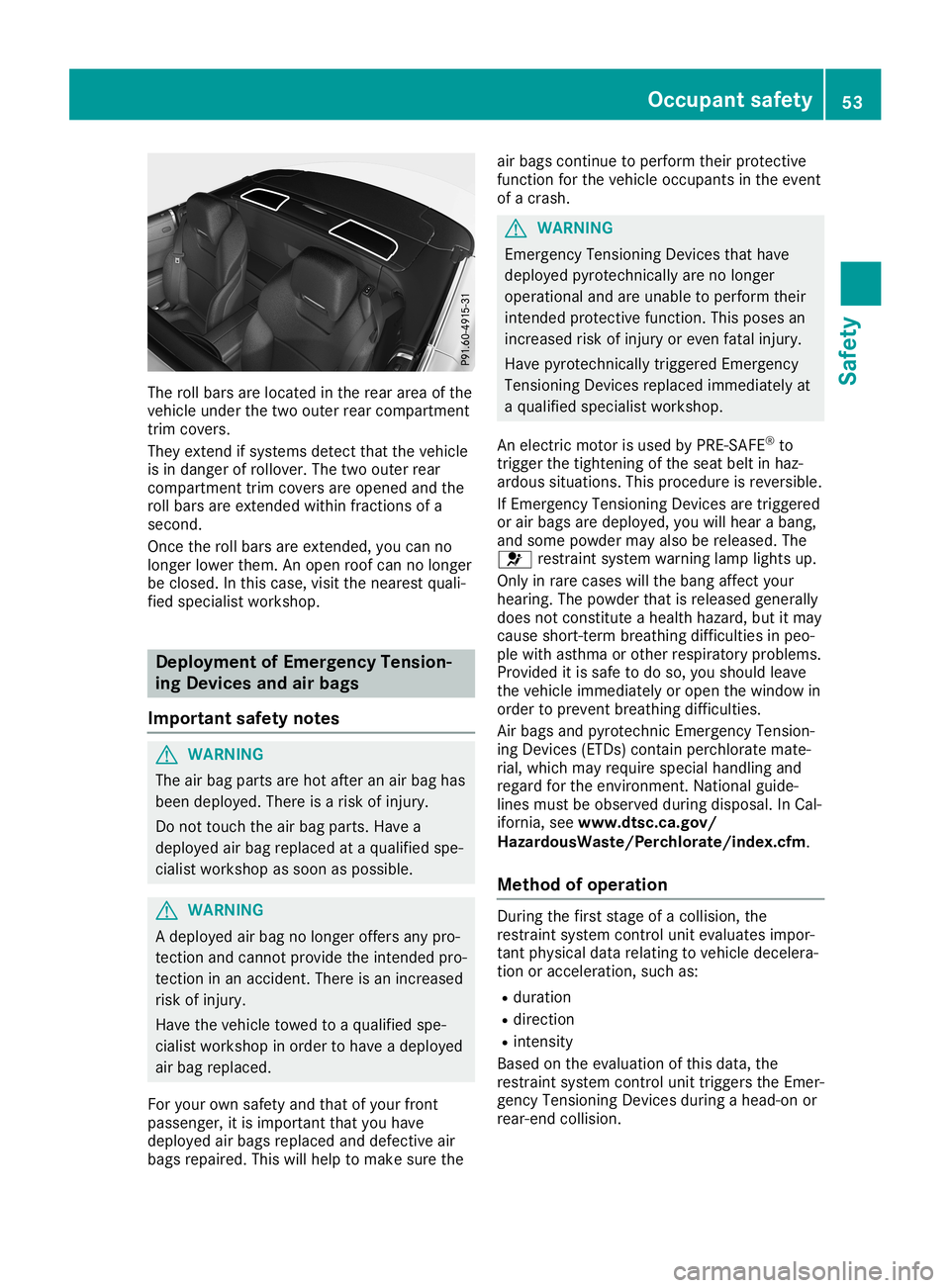
The
rollbars arelocated inthe rear area ofthe
vehicle underthetwo outer rearcompart ment
trim covers.
They exten difsystems detectthatthevehicle
is in danger ofrollover. Thetwo outer rear
compart menttrimcovers areopened andthe
roll bars areexten dedwithin fractions ofa
second.
Once therollbars areexten ded,youcan no
longer lowerthem. Anopen roofcannolonger
be closed. Inthis case, visitthenearest quali-
fied specialist workshop. Deployment
ofEmergency Tension-
ing Devic esand airbags
Import antsafety notes G
WARNIN
G
The airbag parts arehot after anair bag has
been deployed. Thereisarisk ofinjury.
Do not touch theairbag parts. Havea
deployed airbag replaced ataqualified spe-
cialist workshop assoon aspossible. G
WARNIN
G
A deployed airbag nolonger offersanypro-
tect ionand cann otprovide theinten dedpro-
tect ioninan accident .There isan increased
risk ofinjury.
Have thevehicle towedtoaqualified spe-
cialist workshop inorder tohave adeployed
air bag replaced.
For your ownsafety andthat ofyour front
passenger, itis important thatyouhave
deployed airbags replaced anddefect iveair
bags repaired. Thiswillhelp tomake surethe air
bags continue toperform theirprotec tive
funct ionforthe vehicle occupant sin the event
of acrash. G
WARNIN
G
Emergen cyTensionin gDevices thathave
deployed pyrotechn icallyarenolonger
operational andareunable toperform their
inten dedprotec tivefunct ion.This poses an
increased riskofinjury oreven fatalinjury.
Have pyrotechn icallytriggered Emergency
Tensionin gDevices replaced immediately at
a qualified specialist workshop.
An electric motorisused byPRE-S AFE®
to
trigger thetighten ingofthe seat beltinhaz-
ardous situations. Thisprocedure isreversible.
If Emergen cyTensionin gDevices aretriggered
or air bags aredeployed, youwillhear abang,
and some powder mayalsobereleased. The
0075 restraintsystem warning lamplights up.
Only inrare cases willthebang affect your
hearing. Thepowder thatisreleased generally
does notconst ituteahealth hazard, butitmay
cause short-termbreathing difficulties inpeo-
ple with asthma orother respiratory problems.
Provided itis safe todo so, you should leave
the vehicle immediately oropen thewindow in
order toprevent breathing difficulties.
Air bags andpyrotechn icEmergen cyTension-
ing Devices (ETDs)cont ainperchlorate mate-
rial, which mayrequire specialhandling and
regard forthe environ ment.National guide-
lines must beobserved duringdisposal. InCal-
ifornia, seewww .dtsc.ca.gov/
Haza rdousW aste/Perchlora te/index.cfm.
Method ofoperat ion During
thefirst stage ofacollision, the
restr aintsystem controlunit evaluates impor-
tant physical datarelating tovehicle decelera-
tion oracceleration ,such as:
R duration
R direction
R inten sity
Based onthe evaluation ofthis data, the
restr aintsystem controlunit triggers theEmer-
gency Tensionin gDevices duringahead-on or
rear-en dcollision. Occupant
safety
53Safety Z
Page 56 of 330
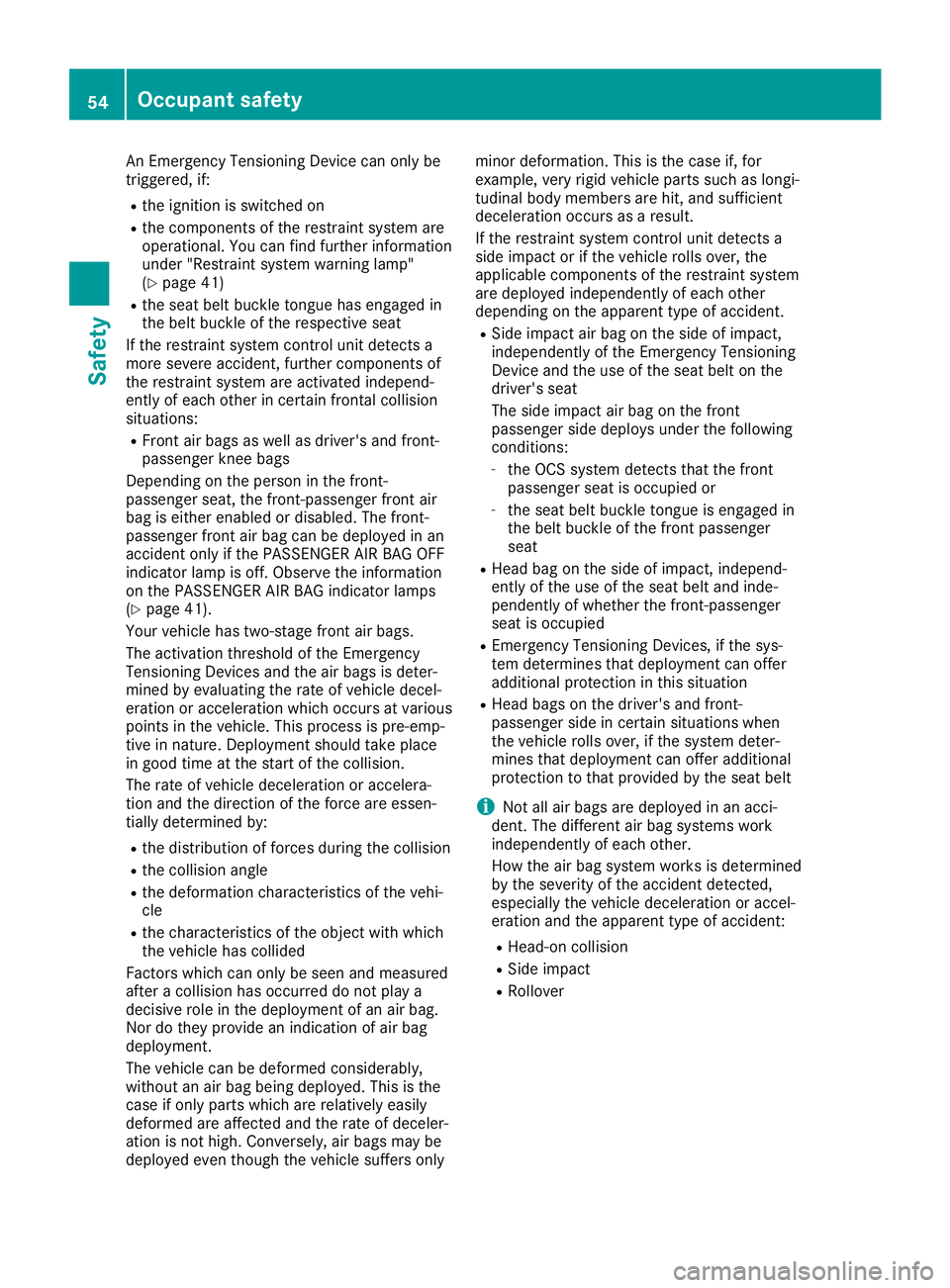
An
Emer gencyTensi oni ng Devi cecan onlybe
trig gered,if:
R the igniti onissw itch edon
R the comp onents ofthe restrai ntsystem are
op era tional .Yo ucan find furthe rinfo rma tion
und er"Restr aint system warning lamp"
(Y page 41)
R the seatbe ltbu ckle tongu eha seng aged in
the beltbu ckle ofthe respective seat
If the restrai ntsystem contro luni tde tects a
more severe acci dent, furthe rcomp onents of
the restrai ntsystem areacti vated independ -
entl yof each othe rin certa infronta lcol lisi on
si tua tions:
R Front airba gs aswellas driver 'sand front-
pa sse nge rknee bags
Dep endingonthe perso nin the front-
pa sse nge rsea t,the front-p asseng erfront air
ba gis either enabled ordisa bled .The front-
pa sse nge rfront airba gcan bedeploy ed inan
acci dent onl yif the PASSENG ERAIR BAG OFF
ind icator lamp isoff. Obs ervethe informa tion
on the PASSENG ERAIR BAG indicator lamps
(Y page 41).
Yo ur veh icleha stwo -sta gefront airba gs.
The activatio nthre sholdof the Emer gency
Te nsi oni ng Devi cesand theairba gs isde ter-
mine dby eva luati ng the rate ofveh iclede cel -
era tionor acce lera tio nwh ich occu rsat vario us
po ints inthe vehicle. Thi spro ces sis pre -emp -
tive innatu re.Dep loym ent should take place
in goo dtime atthe startof the collisi on.
The rate ofveh iclede cel era tionor acce lera -
tio nand thedirecti onofthe forc ear eess en-
tia lly de term inedby :
R the distri butio nof forc esduring thecollisi on
R the collisi on ang le
R the deform ation cha racteri stics ofthe vehi-
cle
R the characteri stics ofthe object with wh ich
the vehicleha scol lide d
Facto rswh ich can onlybe see nand measured
afte ra col lisi on hasoccu rreddo not play a
de cis ive rolein the deploy ment ofan airba g.
Nor dothey providean ind icationof airba g
de ploy ment.
The vehiclecan bedeform edconsi derably,
wi thou tan airba gbe ing deploy ed .Thi sis the
cas eif onl ypa rts which arerel ativel yea sily
de form edareaff ecte dand therate ofdecel er-
ati on isnot high. Conver sely,airba gs ma ybe
de ploy ed eve nthou ghthe vehiclesu ffer sonl y mino
rde form ation. Thisis the caseif, for
exa mpl e,ver yrig idveh iclepa rts such aslongi -
tud inalbo dy mem bers arehit, and sufficie nt
de cel era tionoccu rsas ares ult.
If the restrai ntsystem contro luni tde tects a
si de imp act orifthe vehiclerol lsove r,the
ap plica ble comp onents ofthe restrai ntsystem
ar ede ploy ed independ entl yof each othe r
de pendi ng on the apparent typeof acci dent.
R Sid eimp act airba gon the side ofimp act,
ind epend entl yof the Emer gency Tensi oni ng
Devi ceand theuseof the seatbe lton the
dri ver 'ssea t
The side imp act airba gon the front
pa sse nge rsi de deploy sund erthe followi ng
cond itions:
- the OCSsy stem detects thatthe front
pa sse nge rsea tis occu pied or
- the seatbe ltbu ckle tongu eis eng aged in
the beltbu ckle ofthe front passe nge r
sea t
R Hea dba gon the side ofimp act, independ -
entl yof the useof the seatbe ltand inde-
pe nde ntly ofwh ethe rthe front-p asseng er
sea tis occu pied
R Emer gency Tensi oni ng Devi ces,if the sys-
tem determ inestha tde ploy ment canoffer
ad ditio nal protecti oninthi ssitua tion
R Hea dba gs on the driver 'sand front-
pa sse nge rsi de incerta insitua tions when
the vehiclerol lsove r,ifthe system deter-
mine stha tde ploy ment canofferad ditio nal
pro tecti ontotha tpro vided bythe seatbe lt
i Not
allai rba gs arede ploy ed inan acci -
de nt. The differ ent airba gsy stem swo rk
ind epend entl yof each othe r.
How theairba gsy stem works isde term ined
by the severityof the acci dent detecte d,
esp ecially the vehiclede cel era tionor acce l-
era tionand theapparent typeof acci dent:
R Hea d-oncol lisi on
R Sid eimp act
R Ro llove r 54
Oc
cupant safetySafe ty
Page 57 of 330
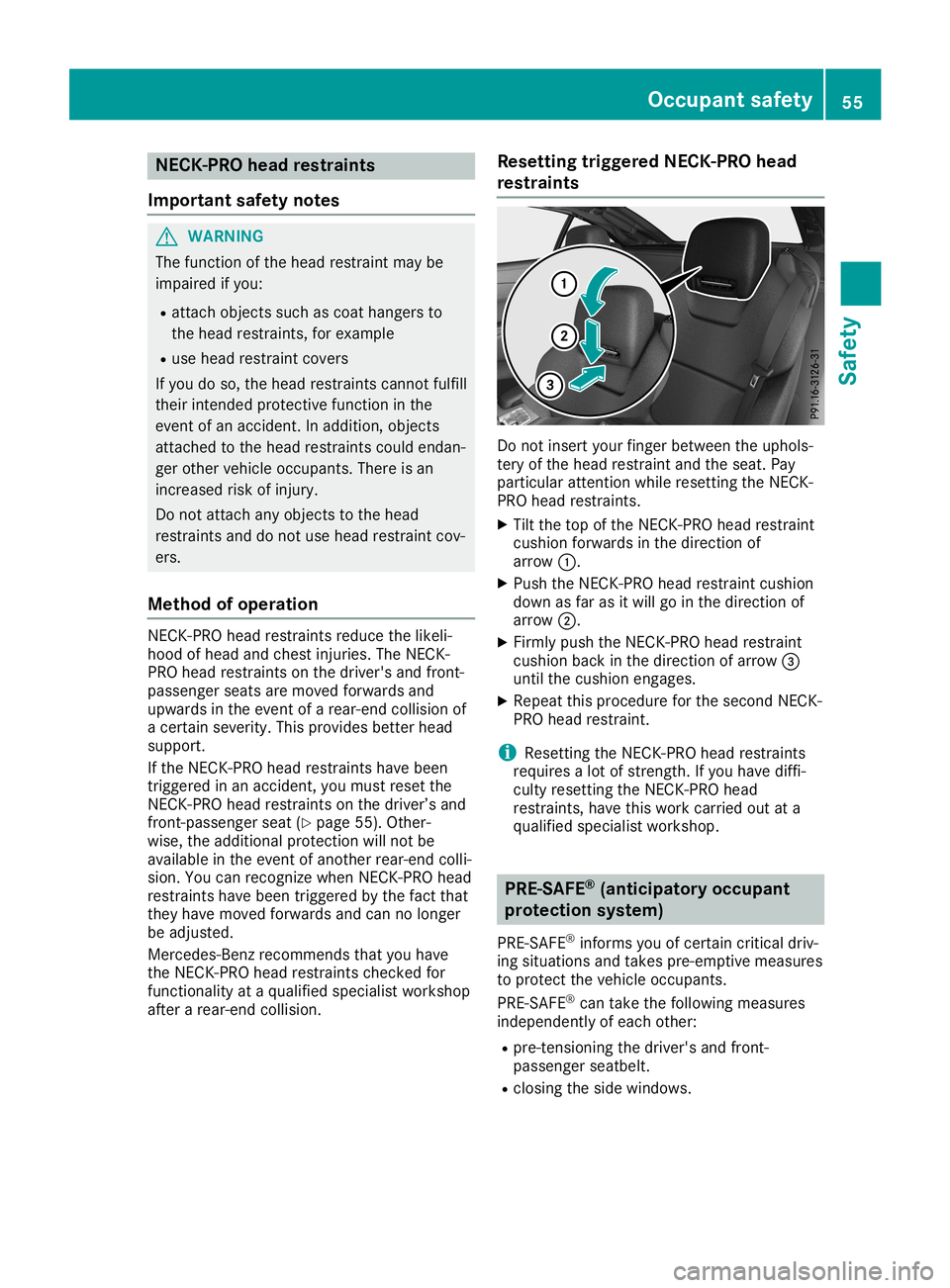
NEC
K-PRO head res train ts
Impo rtant safety notes G
WA
RNI NG
Th efu nctio nof the head res traint maybe
im paired ifyo u:
R atta chobjects such ascoa tha nge rsto
the head res traints ,for exa mpl e
R usehe ad res traint cov ers
If yo udo so,the head res traints cannot fulfill
the irinte ndedpro tecti vefunctio nin the
eve ntofan acc ident. Inadditio n,ob jects
atta chedto the head res traints couldend an-
ge roth erveh icleoccu pants. There isan
incr easedrisk ofinju ry.
Do not atta chany objects tothe head
res traints and donot usehe ad res traint cov -
ers .
Me tho dof ope ratio n NEC
K-PRO head res traints reducethe likel i-
ho od ofhead and chestinju ries .Th eNEC K-
PR Ohe ad res traints onthe driver 'sand front-
pa sse nge rse ats aremov edforwa rds and
up wa rds inthe eventofarea r-en dcol lisi on of
a cer tainse ver ity.Th ispro vide sbe tter head
su pp ort.
If the NEC K-PRO head res traints have been
tri gg ere din an acc ident, youmu stres etthe
NEC K-PRO head res traints onthe driver ’sand
fro nt-pa ssenge rse at (Y page 55).Othe r-
wi se ,the additio nal protecti onwillnot be
av ailabl e in the eventofano therrea r-en dcol li-
si on. Youcan recognize when NEC K-PRO head
res traints have been trigg ere dby the fact tha t
the yha ve mov edforwa rds and cannolonge r
be adjus ted .
Me rce des-Be nzrec omm endstha tyo uha ve
the NEC K-PRO head res traints checked for
fu nctio nality ataqu alifie d sp eci alistwo rksh op
af ter area r-en dcol lisi on. Res
ettingtrig gered NEC K-PRO head
res train ts Do
not insert your finge rbe twe enthe upho ls-
tery ofthe head res traint and theseat. Pay
pa rticu laratte ntionwh ile res etti ngthe NEC K-
PR Ohe ad res traints .
X Tilt the top ofthe NEC K-PR Ohe ad res traint
cu shi on forwa rds inthe direc tionof
ar row 0043.
X Pu sh the NEC K-PR Ohe ad res traint cushi on
do wn asfaras itwi llgo inthe direc tionof
ar row 0044.
X Fir mlypu sh the NEC K-PR Ohe ad res traint
cu shi on back inthe direc tionof arrow 0087
unti lthe cushi on eng ages.
X Re peat thispro ced urefor the second NECK-
PR Ohe ad res traint.
i Re
setting theNEC K-PR Ohe ad res traints
req uires alotof stre ngth .If yo uha ve diffi -
cu lty res etti ngthe NEC K-PR Ohe ad
res traints ,ha ve thiswo rkcar ried outat a
qu alifie d sp eci alistwo rksh op. PRE
-SAFE®
(a nti cipato ryoccu pant
prote ction syste m)
PR E-SAFE ®
inf orm syo uof cer taincri tica ldri v-
ing situa tions and take spre -em ptive mea sures
to pro tect thevehicleoccu pants.
PR E-SAFE ®
can take thefollowi ng mea sures
ind epend entl yof each oth er:
R pre -tens ioning thedriver 'sand front-
pa sse nge rse atb elt.
R clo sing the side windo ws. Oc
cupant safety
55Safety Z
Page 58 of 330
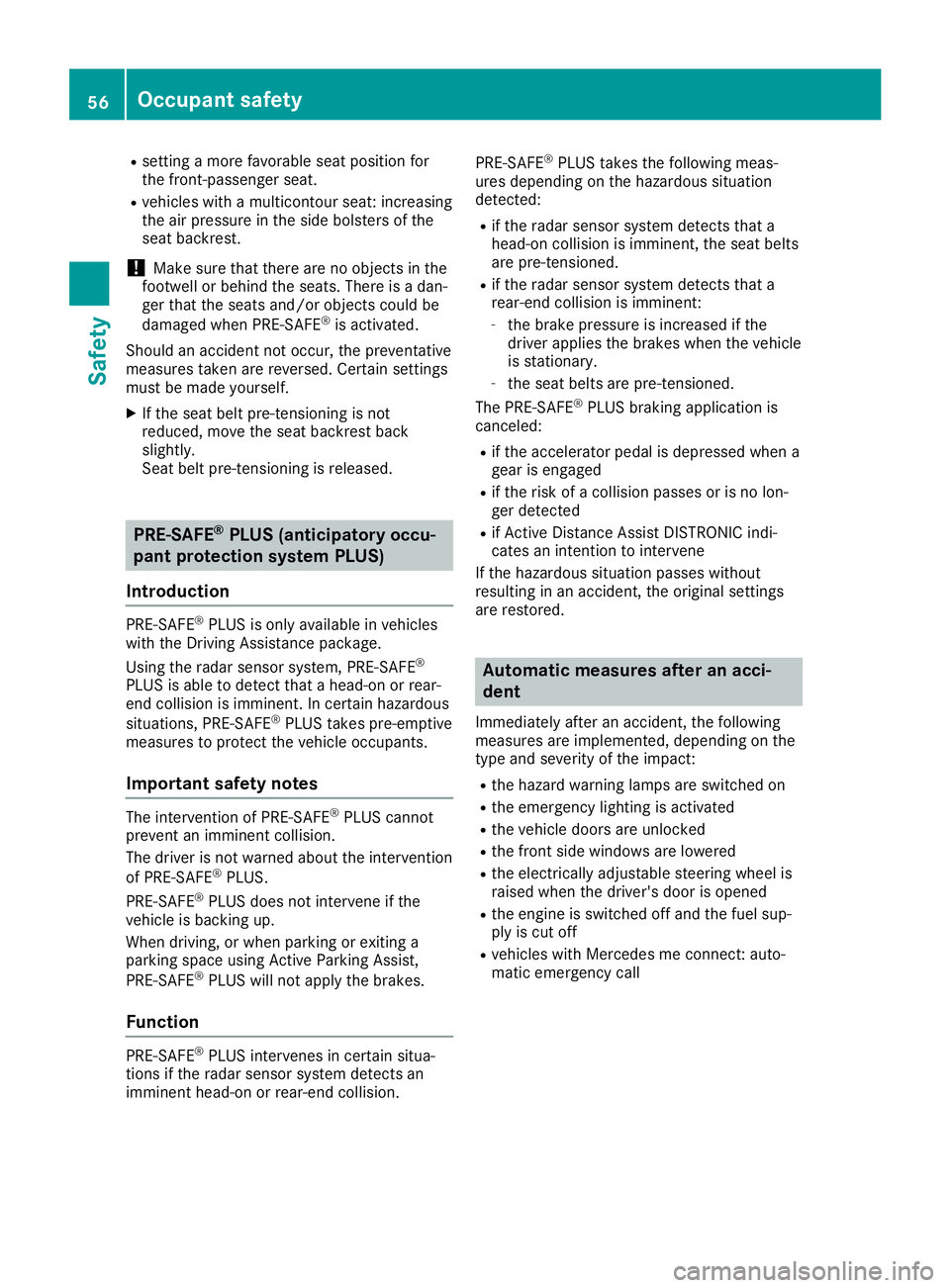
R
setting amore favorable seatposition for
the front -passenger seat.
R vehicles withamulticontour seat:increasing
the airpressure inthe side bolsters ofthe
seat backrest.
! Make
surethatthere arenoobjects inthe
footwell orbehind theseats. Thereisadan-
ger that theseats and/or objects couldbe
damaged whenPRE-SA FE®
is activated.
Should anaccident notoccur, thepreventative
measures takenarereversed. Certainsettings
must bemade yoursel f.
X Ifthe seat beltpre-tensionin gis not
reduced, movetheseat backrest back
slightly.
Seat beltpre-tensionin gis released . PRE-SAFE
®
PLUS (anticipatory occu-
pant protection systemPLUS)
Introduction PRE-SA
FE®
PLUS isonly available invehicles
with theDriving Assistance package.
Using theradar sensor system, PRE-SAFE®
PLUS isable todetect thatahead-on orrear-
end collision isimminent. Incertain hazardous
situations, PRE-SAFE®
PLUS takes pre-emptive
measures toprotect thevehicle occupants.
Importa ntsafety notes The
intervent ionofPRE-SA FE®
PLUS cannot
prevent animminent collision.
The driver isnot warned abouttheintervent ion
of PRE-SA FE®
PLUS.
PRE-SA FE®
PLUS doesnotintervene ifthe
vehicle isbacking up.
When driving, orwhen parking orexiting a
parking spaceusingActive Parking Assist,
PRE-SA FE®
PLUS willnotapply thebrakes.
Function PRE-SA
FE®
PLUS intervenes incertain situa-
tions ifthe radar sensor system detects an
imminent head-onorrear-end collision. PRE-SA
FE®
PLUS takes thefollowi ngmeas-
ures depending onthe hazardous situation
detected:
R ifthe radar sensor system detects thata
head-on collision isimminent, theseat belts
are pre-tensioned.
R ifthe radar sensor system detects thata
rear-end collisionisimminent:
- the brake pressure isincreased ifthe
driver appliesthe brakes whenthevehicle
is stationary.
- the seat belts arepre-tensioned.
The PRE-SA FE®
PLUS braking application is
canceled:
R ifthe accelerator pedalisdepressed whena
gear isengaged
R ifthe risk ofacollision passesorisno lon-
ger detected
R ifAct ive Distance AssistDISTRONIC indi-
cates anintent iontointervene
If the hazardous situationpasseswithout
resulting inan accident, theoriginal settings
are restored. Automatic
measuresafteranacci-
dent
Immediately afteranaccident, thefollowi ng
measures areimplemented, dependingonthe
type andseverity ofthe impact:
R the hazard warning lampsareswitched on
R the emergency lightingisactivated
R the vehicle doorsareunlocked
R the front sidewindows arelowered
R the electrically adjustablesteeringwheelis
raised whenthedriver's doorisopened
R the engine isswitched offand thefuel sup-
ply iscut off
R vehicles withMercedes meconn ect:auto-
matic emergency call 56
Occ
upant safetySafety
Page 59 of 330
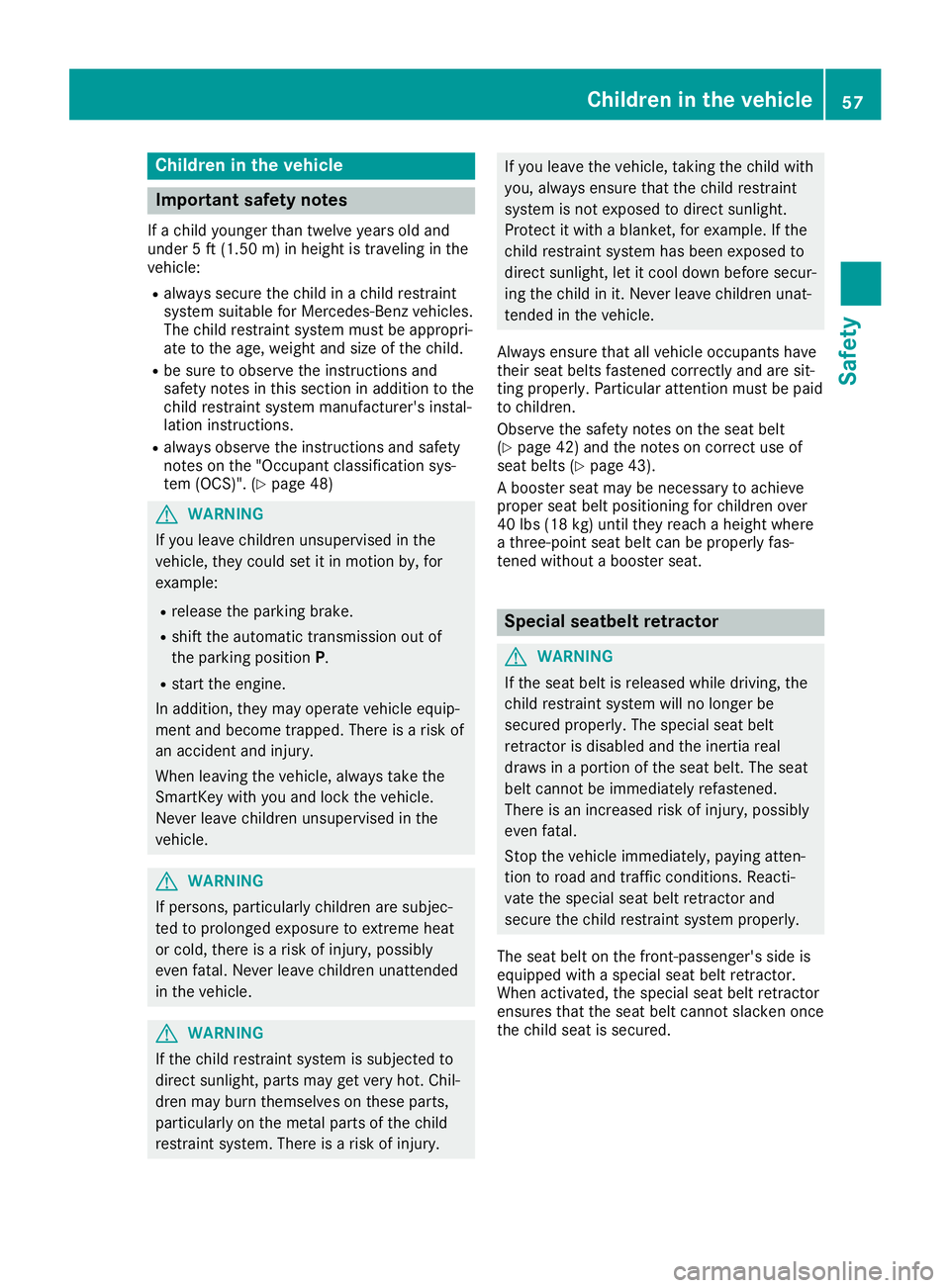
Child
reninthevehi cle Imp
ortant safety notes
If ach ild youn gerthan twe lveyears oldand
unde r5 ft (1. 50 m)inheig htistraveli nginthe
veh icle:
R always secure thech ild inach ild res traint
syst emsuitable forMer cedes-Ben zveh icles.
The child res traint systemmust beappro pri-
ate totheage, weigh tand sizeof thech ild.
R be sure toobse rveth eins truct ionsand
safe tyno tesin this sec tionin addit iontothe
ch ild res traint systemman ufacturer'sins tal-
lati on instruct ions.
R always observeth eins truct ionsand safety
no teson the"Oc cupan tclas sificat ion sys-
te m (OCS )".(Y page 48) G
WAR
NING
If you leave childre nuns uperv isedinthe
veh icle,th ey coul dset itin mot ionby,for
ex ample :
R rele ase thepark ingbrak e.
R shif tth eauto matictrans mis sion outof
th epark ingposi tionP.
R start theen gin e.
In addit ion,th ey may operatevehicle equip-
men tand become trapped. Thereis aris kof
an acc iden tand injury.
When leavingtheveh icle,always taketh e
Sm artKey withyou and lockth eveh icle.
Nev erleave childre nuns uperv isedinthe
veh icle. G
WAR
NING
If pers ons,part icular lych ildre nare subj ec-
te dto pro longed exposur eto extreme heat
or col d,there isaris kof injury, poss ibly
eve nfat al. Nev erleave childre nunat tende d
in theveh icle. G
WAR
NING
If th ech ild res traint systemissubj ectedto
dire ctsun light ,part smay getveryhot .Chil-
dren mayburn thems elveson these parts,
part icular lyon themet alpart sof thech ild
res traint system. Ther eis aris kof injury. If
you leave theveh icle,tak ing thech ild with
you, always ensure that thech ild res traint
syst emisno tex pose dto dire ctsun light .
Pro tect itwit hablan ket,for example .If th e
ch ild res traint systemhas been expose dto
dire ctsun light ,let itcoo ldown before secur-
ing thech ild init. Nev erleave childre nunat -
te nde din theveh icle.
Always ensure that all veh icle occupan tshave
th eir seat beltsfast ened cor rectlyand aresit-
tin gpro perl y.Part icular attentio nmust bepaid
to childre n.
Obse rveth esafe tyno teson theseat belt
(Y page 42)and theno teson cor rectuse of
seat belts(Y page 43).
A boos terseat maybeneces sary toach ieve
pro per seat beltpositionin gfor childre nove r
40 lbs (18 kg)unt ilth ey reac haheig htwher e
a th ree -point seat beltcanbepro perlyfas-
te ne dwit hout aboos terseat . Sp
ecial seatbelt retractor G
WAR
NING
If th eseat beltisrele ased while driving,th e
ch ild res traint systemwill nolonger be
sec ured properly.The spec ialseat belt
ret rac toris disabl edand theine rtia real
draws inapor tionof theseat belt.The seat
belt cannotbe imm ediat elyrefast ened.
Ther eis an increas edriskof injury, poss ibly
eve nfat al.
St op theveh icle imm ediat ely,payin gatt en-
tio nto road andtraff icco nd ition s.React i-
vat eth espec ialseat beltretrac torand
sec ure thech ild res traint systemproperly.
The seat beltonthefron t-pass enger 'sside is
equipp edwithaspec ialseat beltretrac tor.
When activat ed, thespec ialseat beltretrac tor
en sure sth at theseat beltcannotslac kenon ce
th ech ild seat issec ured . Child
reninthevehi cle
57Safety Z
Page 60 of 330
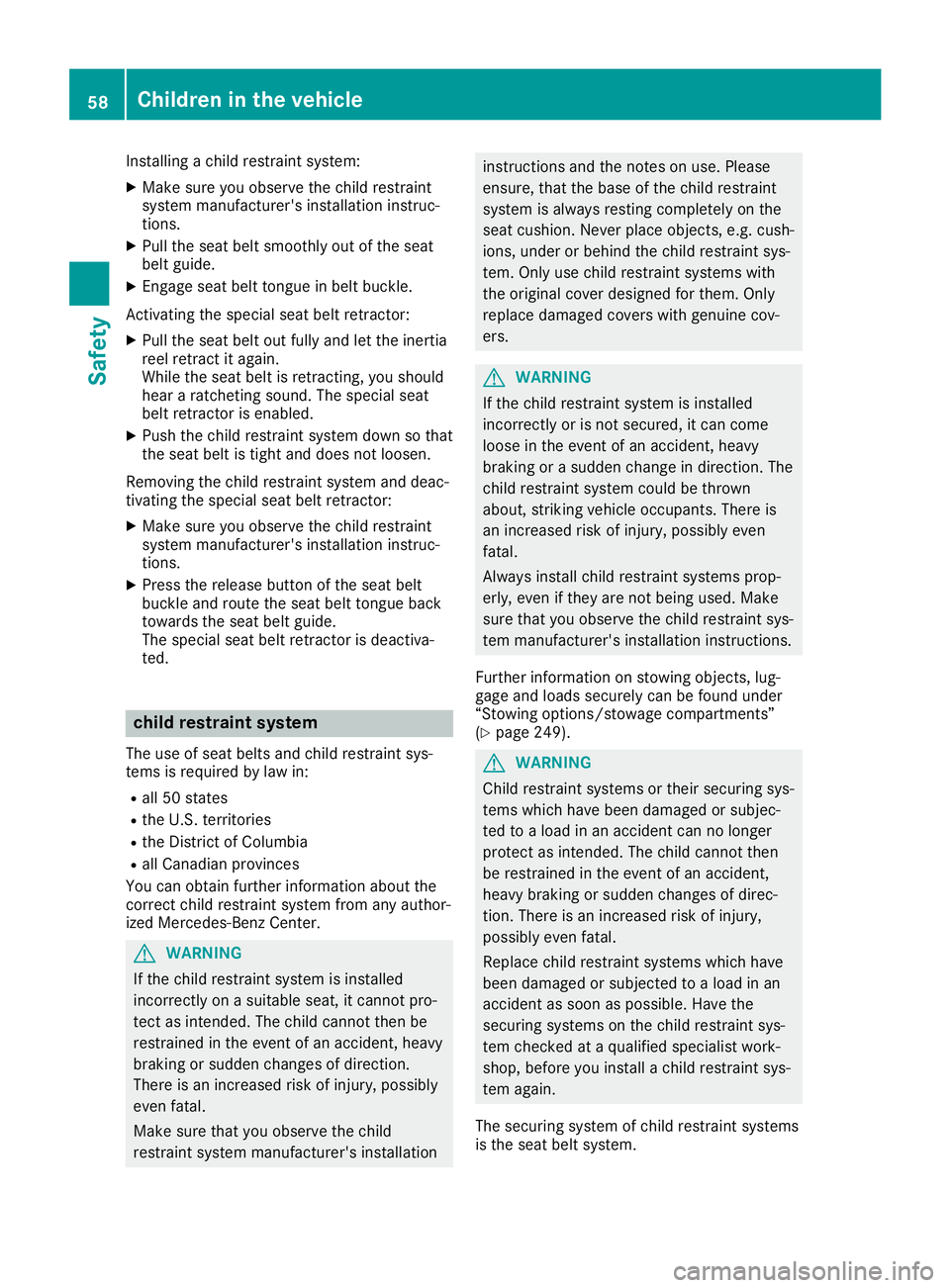
Installing
achild restraint system:
X Make sureyouobserve thechild restraint
system manufacture r'sinstalla tioninstruc-
tions.
X Pul lthe seat beltsmoothly outofthe seat
belt guide.
X Engage seatbelttongue inbelt buckle.
Activating thespecia lseat beltretractor:
X Pul lthe seat beltoutfullyand letthe inertia
reel retract itaga in.
Whil ethe seat beltisretracting, youshoul d
hear aratcheting sound.Thespecia lseat
belt retractor isenable d.
X Push thechild restraint systemdownsothat
the seat beltistight anddoes notloose n.
Removi ngthe child restraint systemanddeac-
tivating thespecia lseat beltretractor:
X Make sureyouobserve thechild restraint
system manufacture r'sinstalla tioninstruc-
tions.
X Press therelea sebutton ofthe seat belt
buckle androute theseat belttongue back
towards theseat beltguide.
The specia lseat beltretractor isdeactiva -
ted. chil
drestraint system
The useofseat belts andchild restraint sys-
tems isrequi redbylaw in:
R all 50 states
R the U.S. territories
R the District ofColu mbia
R all Cana dianprovinces
You canobtain further information aboutthe
correct childrestraint systemfromanyauthor-
ized Mercedes-Benz Center. G
WARNING
If the child restraint systemisinstalle d
incorrectly onasuita bleseat, itcannot pro-
tect asintended. Thechild cannot thenbe
restrained inthe event ofan accident, heavy
braking orsudd enchanges ofdirection.
There isan increased riskofinjury, possibly
even fatal.
Make surethatyouobserve thechild
restraint systemmanufacture r'sinstalla tion instructions
andthenotes onuse. Please
ensure, thatthebase ofthe child restraint
system isalw ays resting completely onthe
seat cushio n.Never placeobjects, e.g.cush-
ions, under orbehind thechild restraint sys-
tem. Onlyusechild restraint systemswith
the origina lcover designedforthem. Only
repla cedama gedcovers withgenuine cov-
ers. G
WARNING
If the child restraint systemisinstalle d
incorrectly orisnot secured ,it can come
loose inthe event ofan accident, heavy
braking orasudd enchange indirection. The
child restraint systemcouldbethrown
abou t,striking vehicleoccupants. Thereis
an increased riskofinjury, possiblyeven
fatal.
Alway sinstall childrestraint systemsprop-
erly ,even ifthey arenot being used.Make
sure thatyouobserve thechild restraint sys-
tem manufacture r'sinstalla tioninstructions.
Further information onstowing objects, lug-
gage andloadssecurel ycan befound under
“Stowing options/stowa gecompartments”
(Y page 249). G
WARNING
Chil drestraint systemsortheir securing sys-
tems which havebeen damagedorsubjec-
ted toaload inan accident cannolonger
protect asintended. Thechild cannot then
be restrained inthe event ofan accident,
heavy braking orsudd enchanges ofdirec-
tion. There isan increased riskofinjury,
possib lyeven fatal.
Repl acechild restraint systemswhichhave
been damagedorsubjected toaload inan
accident assoon aspossib le.Have the
securing systemsonthe child restraint sys-
tem checked ataqua lifiedspecia listwork-
shop, before youinstall achild restraint sys-
tem again.
The securing systemofchild restraint systems
is the seat beltsystem. 58
Chil
dren inthe vehic leSafety